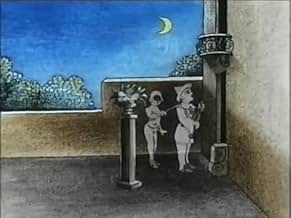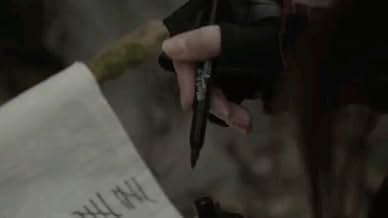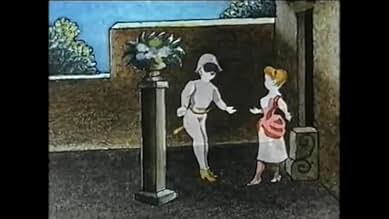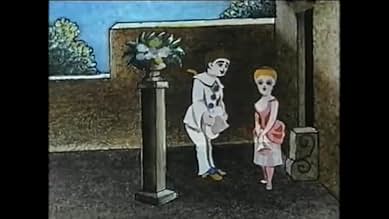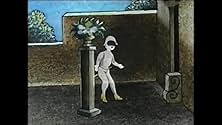NOTE IMDb
6,5/10
2,2 k
MA NOTE
Une nuit, Arlequin vient voir son amant Colombine. Puis Pierrot frappe à la porte et Colombine et Arlequin se cache. Pierrot commence à chanter mais Arlequin l'effraie et le pauvre homme s'e... Tout lireUne nuit, Arlequin vient voir son amant Colombine. Puis Pierrot frappe à la porte et Colombine et Arlequin se cache. Pierrot commence à chanter mais Arlequin l'effraie et le pauvre homme s'en va.Une nuit, Arlequin vient voir son amant Colombine. Puis Pierrot frappe à la porte et Colombine et Arlequin se cache. Pierrot commence à chanter mais Arlequin l'effraie et le pauvre homme s'en va.
- Réalisation
- Scénario
Avis à la une
This is a very, very, very, very impressive movie for 1892. Yes, 1892! Edison was still experimenting with his Kinetoscope in America, Etienne-Jules Marey was using his Chronophotographic Gun to shoot film experiments, and films were, like, 3 seconds! Charles-Emile Reynaud's "Pauve Pierrot" originally ran 15 minutes, is in painted color by Reynaud himself, and (drum-roll, please) is animated! 1892, and this is the first cartoon! It consists of 500 images, tells a story, and is something you'd think came much, much later than this!
That's not to say it doesn't have any flaws. It definitely does. For one thing, while this is animation, it is very, very primitive looking by today's standards. The figures' movements are jerky, and at times they don't move at all. One particularly poorly animated spot is when Colombine comes out to meet Harlequin, as well as when she opens the door for Pierrot. Also, while sometimes there is some cutting closer to the figures, we mostly view what's going on from a single vantage point. If you decide to see this, bear in mind that, while ground-breaking, the animation isn't anything like what you'd see nowadays.
It's so sad. So much of Reynaud's work is lost today. The only other available cartoon from him is "Autour d'un Cabine" from 1894. His other two cartoons, "Le Clown et ses Chiens" and "Un Bon Bock" were both thrown into the Seine by Reynaud himself. Luckily, he spared these two movies so they could be seen and appreciated today.
That's not to say it doesn't have any flaws. It definitely does. For one thing, while this is animation, it is very, very primitive looking by today's standards. The figures' movements are jerky, and at times they don't move at all. One particularly poorly animated spot is when Colombine comes out to meet Harlequin, as well as when she opens the door for Pierrot. Also, while sometimes there is some cutting closer to the figures, we mostly view what's going on from a single vantage point. If you decide to see this, bear in mind that, while ground-breaking, the animation isn't anything like what you'd see nowadays.
It's so sad. So much of Reynaud's work is lost today. The only other available cartoon from him is "Autour d'un Cabine" from 1894. His other two cartoons, "Le Clown et ses Chiens" and "Un Bon Bock" were both thrown into the Seine by Reynaud himself. Luckily, he spared these two movies so they could be seen and appreciated today.
Pauvre Pierrot, directed by Charles-Émile Reynaud, is one of the first animated films ever made. It is made up of 500 individually painted images and originally lasted about 15 minutes. The version available to today is a 4 minute version, restored from pieces of the original.
It's a simple story of a woman with two men wooing her, one she cares for, and the other which is somewhat a nuisance to her, even if he is sincere. To achieve his effects, Reynaud invented his Théâtre-Optique system which was basically a zoetrope with a projector. The images showed successive images of moving figures in front of blackbackgrounds. These images could be adjusted in real-time to project tthe animated characters against an immobile background image which was being projected by a second projector from a painted glass plate.
At times the show was quite elaborate. Original music and songs were written for the show, played by an piano accompanyist and sung by an actor. Reynaud performed 12,800 shows from 1892 to 1900. Commercially successful for a time, the popularity of these shows were eventually overtaken by the projected camera live action films of the Lumières and others.
It's a simple story of a woman with two men wooing her, one she cares for, and the other which is somewhat a nuisance to her, even if he is sincere. To achieve his effects, Reynaud invented his Théâtre-Optique system which was basically a zoetrope with a projector. The images showed successive images of moving figures in front of blackbackgrounds. These images could be adjusted in real-time to project tthe animated characters against an immobile background image which was being projected by a second projector from a painted glass plate.
At times the show was quite elaborate. Original music and songs were written for the show, played by an piano accompanyist and sung by an actor. Reynaud performed 12,800 shows from 1892 to 1900. Commercially successful for a time, the popularity of these shows were eventually overtaken by the projected camera live action films of the Lumières and others.
J. Stuart Blackton's 'Humorous Phases of Funny Faces (1906)' is generally held as the first animated film. Indeed, it was the first animated film made on motion-picture film, but such history is nevertheless unfair to Émile Reynaud, who, fourteen years earlier, was projecting moving animated images to delighted audiences. 'Pauvre Pierrot (1892)' is one of the director's few surviving works (most were, in a fit of frustration, discarded into the Seine by the director himself), and such a colourful and charming curio remains a delight to behold.
Reynaud animated each frame himself – 500 in total (36 metres long) – and extended the film to 12-15 minutes by personally manipulating the picture-bands during the projection. The story told is a simple one: Pierrot and Arlequin compete for the romantic attention of Colombine, a beautiful maiden. One potential suitor attempts to charm the good lady with a lute performance, but his competitor goes one better with a baton or sword of some sort.
Reynaud's moving picture show, billed as "Théâtre Optique" or "Pantomimes Lumineuses," included a triple-bill of three films: 'Pauvre Pierrot,' 'Un bon bock (1892),' and 'Le Clown et ses chiens (1892).' One contemporary newspaper reported that Reynaud "creates characters with expressions and movements so perfect that they give the complete illusion of life." The show was initially a great success, but, in 1918, Reynaud died a poor man. His delicate work, prone to rapid degradation, could not compete with the Lumière brothers' cinematograph, which depicted real-life, and not merely an animated approximation.
Reynaud animated each frame himself – 500 in total (36 metres long) – and extended the film to 12-15 minutes by personally manipulating the picture-bands during the projection. The story told is a simple one: Pierrot and Arlequin compete for the romantic attention of Colombine, a beautiful maiden. One potential suitor attempts to charm the good lady with a lute performance, but his competitor goes one better with a baton or sword of some sort.
Reynaud's moving picture show, billed as "Théâtre Optique" or "Pantomimes Lumineuses," included a triple-bill of three films: 'Pauvre Pierrot,' 'Un bon bock (1892),' and 'Le Clown et ses chiens (1892).' One contemporary newspaper reported that Reynaud "creates characters with expressions and movements so perfect that they give the complete illusion of life." The show was initially a great success, but, in 1918, Reynaud died a poor man. His delicate work, prone to rapid degradation, could not compete with the Lumière brothers' cinematograph, which depicted real-life, and not merely an animated approximation.
"Pauvre Pierrot" is apparently the first animated film and you probably want to read IMDB's trivia section on how the film was made. All I know is that the copy floating about YouTube is gorgeous and looks nothing like you'd expect a film that is 127 years old!
The story is very simple...something I'd expect from 1892 since films were just invented and complex stories were still not made for several years to come. The animation is very jerky (due to a low cel count) but speeding up the film could correct this...so if you find a copy and play it on Media Player Classic (for example), you can double the speed and it would look better.
As for the story, it's very, very simple and involves the classic Commedia dell'arte character, Pierrot, moving about on the screen with a girl. Not exactly thrilling today...but remember...it was 1892 and for that time, this is a really amazing piece of art.
The story is very simple...something I'd expect from 1892 since films were just invented and complex stories were still not made for several years to come. The animation is very jerky (due to a low cel count) but speeding up the film could correct this...so if you find a copy and play it on Media Player Classic (for example), you can double the speed and it would look better.
As for the story, it's very, very simple and involves the classic Commedia dell'arte character, Pierrot, moving about on the screen with a girl. Not exactly thrilling today...but remember...it was 1892 and for that time, this is a really amazing piece of art.
Pauvre Pierrot (1892)
This French film is considered one of the first animated movies ever made. From original reports it seems that the movie lasted longer than what's available in its current version but even at just four-minutes you can't help but be somewhat amazed at what great quality the film actually is. The plot is quite simple and deals with two men and a woman that they both want.
I will just leave the story at that but the main reason to watch this is for the beautiful animation. Now, it should go without saying but this movie was made in 1892 so one really shouldn't be expecting the work of Walt Disney. The film has a very fresh look to it and I must say that the colorful background is certainly the highlight.
This French film is considered one of the first animated movies ever made. From original reports it seems that the movie lasted longer than what's available in its current version but even at just four-minutes you can't help but be somewhat amazed at what great quality the film actually is. The plot is quite simple and deals with two men and a woman that they both want.
I will just leave the story at that but the main reason to watch this is for the beautiful animation. Now, it should go without saying but this movie was made in 1892 so one really shouldn't be expecting the work of Walt Disney. The film has a very fresh look to it and I must say that the colorful background is certainly the highlight.
Le saviez-vous
- AnecdotesThe cartoon was hand drawn on hundreds of sheets of glass, each inlaid in a leather strips, through which a light was shone projecting the figures on a backdrop, as it was spooled from one reel to another, much like a modern film reel.
- ConnexionsFeatured in La magie Méliès (2002)
Meilleurs choix
Connectez-vous pour évaluer et suivre la liste de favoris afin de recevoir des recommandations personnalisées
Détails
- Date de sortie
- Pays d’origine
- Langue
- Aussi connu sous le nom de
- Poor Pierrot
- Voir plus de crédits d'entreprise sur IMDbPro
- Durée5 minutes
- Mixage
Contribuer à cette page
Suggérer une modification ou ajouter du contenu manquant

Lacune principale
By what name was Pauvre Pierrot (1892) officially released in Canada in English?
Répondre
